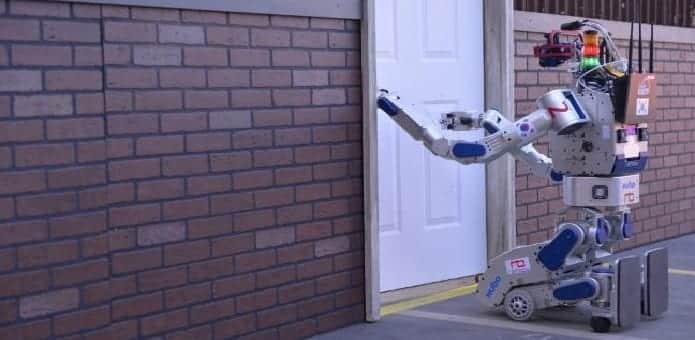South Korean Team ‘KAIST’ and its Robot DRC-Hubo Wins $2 million by cracking the finals at DARPA Robotics Challenge
A South Korean team claimed a $2 million prize on Saturday at the DARPA Robotics Challenge Finals in California. Twenty-five teams of university and corporate roboticists competed for the prize, which was first proposed in the year 2012 by the Defense Advanced Research Projects Agency. The robots were judged on their ability to complete eight tasks, including driving a vehicle, opening a door, operating a portable drill, turning a valve and climbing stairs, all in the space of an hour.
The Korean victory is a validation of the work of JunHo Oh, the designer of the Hubo family of humanoid robots in development since 2002. The winning Hubo is a clever machine that can kneel and drive on wheels in addition to walking.
The Institute of Human and Machine Cognition in Pensacola Robotics of Pensacola, Fla., and its Running Man robot was the second place winner who received $1 million and the the third-place winner, Tartan Rescue, from the National Robotics Engineering Center at Carnegie Mellon University in Pittsburgh, received $500,000.
Despite clear progress since a trial event in Florida in 2013, the robots remain decades away from the science-fiction feats seen in movies like “Ex Machina” and “Chappie. The robots seemed more like an array of electronic and hydraulic contraptions. In some cases, they walked in a lumbering fashion on two or four legs and, in other cases, rolled on tracks or wheels. Some of the machines weighed more than 400 pounds. They were equipped with sensors and cameras to permit remote control.
The first Robotics Challenge took place on Friday until 2:30 in the afternoon for the robot to successfully complete the course, seven and a half hours after the competition began. Frequently, the machines would stand motionless for minutes at a time while they waited for wireless connections with their controllers to improve. Darpa degraded the wireless links on purpose to create the uneven communications that would simulate a crisis situation.
Reporters were once again left grasping for appropriate metaphors to describe the slow-motion calisthenics performed by the menagerie of battery-powered machines. Most of them agreed that “like watching grass grow” was no longer the best description. Gill Pratt, the Darpa official who was in charge of the competition, stated that it had risen to the level of “watching a golf match.”
During the final round, the robots ran without power cords or rope belays in order to prevent them from falling. Therefore, there were numerous falls as robots collapsed through doorways, tumbled backward off short staircases and keeled over while failing to grasp a valve that they were required to turn.
Despite of all these incidents, the competition also offered a real sense of drama on Friday and Saturday, as the lead seesawed back and forth among different teams. There was a crowd of seven thousand people to motivate and cheer them up. One of the robots finished his task in sympathy when a machine failed or tumbled.
The competition was unveiled after Japan’s earthquake, tsunami and nuclear disaster which occurred in the year 2011. This challenge intended to accelerate development in robotics so that they are able to enter disaster-stricken areas that are too dangerous for humans.
Dr. Pratt argued that if remotely operated robots had been available after the quake, the nuclear plant meltdowns and this situation would have been avoidable. He also said that “During the first day or two, things could have changed and the disaster could have been controlled. There had been some way to go in there despite the power being off and operate some of the emergency equipment they had.”
On December 2013, Schaft, a Japanese robotics company which Google acquired, won the competition at the trials which was held at the Homestead International Speedway. The Japanese team, which had spun off from the University of Tokyo to circumvent restrictions on military research, successfully completed all of the tasks they tried.
But after their success, Google decided to remove the team from the competition. During the finals, the Schaft technology contributed to a redesign of seven bipedal Atlas robots that were supplied to teams in the contest by Boston Dynamics, another company that Google acquired.
After Team Schaft’s departure, the Japanese government intervened and arranged funding from the education ministry. As a result, five Japanese teams entered the contest this year, along with teams from the United States, China, Hong Kong, Germany, South Korea and Italy.
While there was relatively modest progress towards completely autonomous and mobile robots at the event, Darpa increased its emphasis this year on the idea of human-robot collaboration as a way to complete tasks that neither humans nor machines could perform separately.
It was also clear at the event that like the Japanese, Americans also had a growing affinity for robots. The contest was accompanied by an extensive exhibition in which dozens of companies, national laboratories and universities demonstrated robots to an appreciative crowd that included many children.
Rich Mahoney, director of the robotics program at SRI International said “People name their cars — it’s a human tendency to build relationships with the things around you. The more those things are like you and are animated and they move, the more we can build relationships with machines.”

